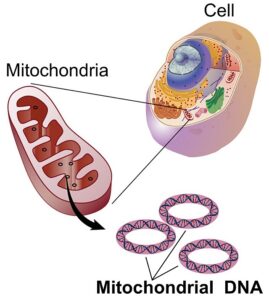IB Biology SL (Standard level)- 2024 – Practice Questions- All Topics
Topic 1.5 The origin of cells
Topic 1 Weightage : 17 %
All Questions for Topic 1.5 –Non-living Synthesis, Biogenesis, Endosymbiosis, Origins of Life, RNA World Hypothesis ,Oxygen Enrichment
What is evidence for the endosymbiotic theory?
A. RNA can catalyse metabolic reactions.
B. Meteorites contain organic molecules.
C. Amino acids can be synthesized from inorganic compounds.
D. Mitochondria possess their own DNA.
▶️Answer/Explanation
Markscheme
D

Endosymbiosis is simply a organism living within another organism with a symbiotic relationship. Mitochondria provides energy at a cellular level and reproduce within your cells. Their numbers map to cell health, athletic ability and aging. Strenuous exercise promotes their numbers. Mitochondrial DNA has limited yet very important role in transcribing crucial proteins involved in oxidative phosphorylation reactions. Mitochondrial DNA contains 37 genes, all of which are essential for normal mitochondrial function. Thirteen of these genes provide instructions for making enzymes involved in oxidative phosphorylation. The remaining 24 genes are involved in the creation of transfer RNA (tRNA) and ribosomal RNA (rRNA) which help to turn amino acids into proteins. The important thing about their DNA is that mitochondria are only passed from the mother to children. They are too big and heavy for sperm to carry about. Thus, geneticists can use mitochondrial DNA to trace the maternal linkage.
Question
Which statement provides evidence for endosymbiosis?
Early prokaryotes contributed to a large increase in oxygen in the atmosphere.
Eukaryotic mitochondria and chloroplasts have their own circular DNA.
Certain groups of ancient prokaryotes developed mechanisms to carry out aerobic respiration.
Experiments by Miller and Urey produced simple organic molecules in abiotic conditions.
▶️Answer/Explanation
Ans: B

Prokaryotic cells have circular DNA and that mitochondria and chloroplasts, which are organelles of eukaryotic cells, also have their own circular DNA. This is one of the statements that provides evidence for endosymbiosis, because it suggests that mitochondria and chloroplasts were once independent bacteria that were engulfed by a larger cell and became part of it. Another evidence is that mitochondria and chloroplasts have their own ribosomes and can replicate independently of the host cell.